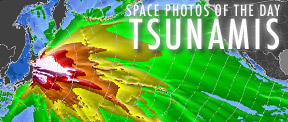 The tsunami waves unleashed across the Pacific by an 8.9-magnitude earthquake off the Japan coast have destroyed boats and docks in a few isolated places along America’s West Coast, but early reports suggest little widespread damage.
The tsunami waves unleashed across the Pacific by an 8.9-magnitude earthquake off the Japan coast have destroyed boats and docks in a few isolated places along America’s West Coast, but early reports suggest little widespread damage.
Crescent City, Calif., near the Oregon border appears to have been hit hardest so far, with the tsunami crushing the city’s docks and as many as 35 boats, according to local reports. “The harbor has been destroyed,” City Councilman Rich Enea told the Times-Standard.
Farther down the coast in Santa Cruz, Calif., one 30-foot boat sank, and a dock “just blew up. It buckled and splintered” in the waves, an eyewitness told the San Jose Mercury-News.
Parts of the Hawaiian islands also reported a seven-foot ocean surge – in one case inundating a Big Island hotel lobby – in the early hours of the morning, though things were now “rapidly becoming business as usual across the state,” according to the Hawaii Convention and Visitors Bureau.
Many coastal areas of Hawaii, California, and Oregon were evacuated early Friday morning. But as the day wore on, gawkers gathering along the West Coast have claimed that there was little to see. Surfers were even in the water not far from Santa Cruz, the Mercury-News reported.
Yet scientists caution that tsunami waves could continue to grow for as many as 12 hours. Wednesday afternoon, a tsunami warning – which suggests coastal evacuation – remained in effect from Point Concepcion, Calif., north of Santa Barbara to the Oregon-Washington border.
For its part, Crescent City is particularly prone to tsunami damage because the topography of the sea floor off the coast concentrates and funnels waves toward the town. But the appearance of calm along the rest of the West Coast was a significant concern for emergency personnel.
In Santa Monica, Calif., near Los Angeles, where a tsunami advisory was still in effect as of Friday afternoon, people openly scoffed as a lifeguard in a yellow van shuttled between camera-toting bystanders, telling them to leave the beach.
“No one here is taking this seriously,” the life guard says. “I have to keep circling and telling them over and over. ”
The attendant at Sea Mist Skate and Bike Rentals just off the boardwalk wasn’t buying the warnings.
“The authorities have totally oversold this danger,” he quipped. “I was here in 1983 when 20-foot waves crashed through the pier, and I lived to tell about it. Six foot wave warnings don’t even concern me.”
But scientists say tsunamis are not normal waves and should not be dismissed lightly. Even a wave as small as six inches high can “grab your feet and knock you down,” says Paul Huang, a seismologist at the Alaska Tsunami Warning Center in Palmer.
That’s because “the entire ocean is pushing a tsunami wave.” In contrast, he says, waves created by the wind might go down 10 or 20 feet, “but the rest of the ocean is still.”
Eyewitnesses in Santa Cruz compared the surge there with a massive river. “It was like a 10 to 15 mile an hour current,” resident Michael Sack told the Mercury-News. “It started slow and came up about five feet.”
This points to one of the challenges of tsunami emergencies, says former FEMA administrator Carlos Castillo. “People underestimate the danger because they don’t see the big picture,” he says.
They look out their window and see a calm sea or a pretty blue sky and say to themselves, “How bad can it be,” he says. “That’s why officials with more information put out warnings and advisories, and people need to pay attention to what they say.”
Part of the disconnect is that people don’t immediately grasp the local connection to a seismic event half a world away. The initial tsunami wave moves across the ocean at about 650 miles an hour – the speed of jet plane – and thus takes about 12 hours to cross from Japan to the US West coast. Following waves travel nearly as fast. csm
Leave a Reply
You must be logged in to post a comment.